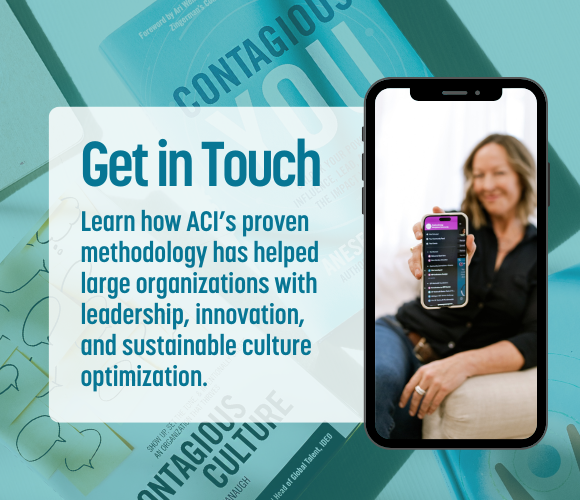If you have it, you rarely think about it. If you don't have it, you likely grapple with it--even if you don't realize it. It mends wounds, inspires creativity, creates true engagement, allows for real relating, results in better and bigger ideas, provides a safety net for taking risks, creates safety and intimacy, and simply feels good. It's essential to "right relationship" and it's one of your strongest units of leadership and human currency. What is it?
If you have it, you rarely think about it. If you don't have it, you likely grapple with it--even if you don't realize it. It mends wounds, inspires creativity, creates true engagement, allows for real relating, results in better and bigger ideas, provides a safety net for taking risks, creates safety and intimacy, and simply feels good. It's essential to "right relationship" and it's one of your strongest units of leadership and human currency. What is it?
Trust.
This word is thrown around almost as much as the word "busy".
It's often taken for granted, abused, danced around, or even used as a scapegoat to avoid conflict and collaboration. ("No, really, I totally trust you." When you really totally don't. But that bigger conversation would be harder, so...)
But when it's in place and grounded--it can move mountains.
I'm not being flip about it. I'm not inferring it should be easy. No. Trust is tricky.
When we trust someone, we are energetically leaning into them, opening up a part of ourselves; our vulnerability, our needs, our dependence on them to show up and get something done, our career growth, to simply BE there, to have our back, to not judge, to make us a priority in their choices, to have integrity and do what they say they'll do. In a nutshell, we're trusting they'll "hold our rope" in whatever way the scenario calls for and in whatever way feels best to us. (Which, by the way, is very useful to communicate, proactively, in relationship.)
This is a big deal.
We've all had trust built, trust broken, and trust questioned, and, intentionally or not, we've all been on both sides of the equation.
In an organization, the level of safety, risk taking, and how much they can innovate is a direct reflection of the level of trust within that organization.
How a leadership team holds trust, has each others' backs and shows up for others, is directly reflected in how others "down the line" do the same.
How much we trust ourselves, and our own relationships with trust and trusting others, is reflected everyday in everything from casual conversations to major decisions.
Trust is a core ingredient for leadership success, and as with intention, energy, and presence, trust is much like food coloring in water--the quality of it permeates everything.
So how do you build trust? And what do you do when it's broken?
I find building trust, and the paths forward, are so individual and personal that I debated whether or not to offer up a "list".
That said, in my years working with humans and business leaders I've found some common themes and effective things to pay attention to that nourish and build trust--or erode it. Play with the ones that resonate for you.
First... "Check yourself before you wreck yourself"--start with YOU.
- What is your OWN level of self-trust? If this is low, it's going to be really hard to trust others and will likely be reflected back at you.
- Are YOU trustworthy? Really look at this one. Are you? If you're not, how can you build trust? Choosing to become trustworthy is a solid step.
Self-trust and the decision and intention to be trustworthy are two foundational elements of building trust. You have a ton of control here--after all, it's YOU.
And... here are 9 high leverage ways to build trust.
- Do what you say, say what you'll do, let people know what they can count on you for; keep your promises.
- Give honest (and productive) feedback in service of others.
- Ask for feedback, receive with grace and gratitude, integrate as it serves.
- Say "I don't know" when you don't know. Ask for help. Be real.
- Own your mistakes. Clean them up. Don't throw others under the bus.
- Don't gossip. Period.
- Go directly to the source--no triangles, no back channels--leader up.
- Name it. Whatever it is you're trying to dance or manipulate around--just name it.
- Be present. Fully present.
And when trust is breeched?
If you are the trust breecher:
- Name the problem
- Own it
- Apologize for it, if applicable and it was good intentions gone awry, explain it (but don't make excuses--own it and share the intention)
- State/ask what you'll do/can do to make it right
- Co-design next steps that feel good for both of you. What do you both need to (re)establish trust?
If you are the trust breechee:
- Identify and acknowledge the emotion for yourself (hurt, anger, fear, disappointment, etc.)
- Check your assumptions
- Name the issue with the other person (this is a good place to share impact and check assumptions)
- Listen to them--bonus if you can listen for the positive intention that went awry
- Co-design next steps that feel good for both of you, forgive, make new agreements, move on... life is short and we've lots to do.
Ready? Go.
This article first appeared on Inc.com on June 6, 2016.
Next Steps
- Share this post with your network or add your comment below!
- Subscribe to The Beat - the weekly reflection and accountability tool
- Learn more about creating a Contagious Culture in your work and life
.png)







